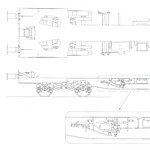
 |
 |
 |
 |
 |
| Resources Menu |
| Index |
| Photo websites |
| Other websites |
| Publications |
| Downloads |
| Publications | ||||||||||||||
| There have been a variety of published items on the subject of British goods railway wagons and this page lists most of those that cover the modern period. If you have any suggestions for additional titles to include, please contact me. | ||||||||||||||
|
||||||||||||||
| Wagon Detail Books | ||||||||||||||
| These are books that cover all the types within their subject, and have substantial text and/or drawings in addition to photographs. The first three titles listed are really the 'bibles' for those interested in wagons, between them covering most of the period from 1948 to the mid-1980s. Sadly the two BR books both miss out large sections, while the PO title is long overdue for an update. Although long out of print, all three books are well worth hunting down. There are several books detailing the wagon fleets of the pre-nationalisation companies but these are beyond the scope of this website. |
||||||||||||||
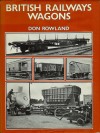 |
Title: | British Railway Wagons - the first half million | ||||||||||||
| Author: | Don Rowland | |||||||||||||
| Publisher: | David & Charles, Newton Abbot, 1985. ISBN: 0-7153-8183-0 | |||||||||||||
| Comments: | 192 pages, almost A4-sized, hard-back with dust-jacket, 175 B&W pictures. 1985 was a good year for wagon books, with two major titles appearing. The first was actually written in 1982 and is an excellent overview of the entire BR wagon fleet from 1948 until about the mid-1960s. As the sub-title suggests, this book focuses more on the 'golden era' of wagon building, and consigns all developments since the introduction of air-brakes to a final chapter headed Apocrypha. In its favour the book does include chapters on departmental wagons and containers, and all chapters are littered with drawings (121 in total, reproduced at 1:76 scale). Most of these are derived from the BR diagrams and lack underframe details and plan views although some very interesting types are included. Another strength of this book is the appendices. The first lists the mineral wagons inherited from the Ministry of War Transport. The second lists all the number ranges used on BR wagons in this period with the lot numbers for each. The third correlates lot numbers to diagram numbers, and the fourth lists all the diagrams with numbering and build details. The mid-1960s cut off means that some types are ommitted but these appendices form a reference that I still use quite regularly. |
|||||||||||||
| --- | ||||||||||||||
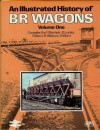 |
Title: | An Illustrated History of British Railways (Revenue) Wagons - Volume One | ||||||||||||
| Authors: | Paul Bartlett, David Larkin, Trevor Mann, Roger Silsbury and Andrew Ward | |||||||||||||
| Publisher: | Oxford Publishing Company, Poole, 1985. ISBN: 0-86093-203-6 | |||||||||||||
| Comments: | 192 pages, almost A4-sized, hard-back with dust-jacket, 223 B&W pictures. The second title to appear was a combined effort by some of the big names in wagon research at the time, and it feels like a more quality production, with larger pictures on glossy paper and more detailed drawings. Unfortunately this book only covers part of the fleet (open wagons, tanks, steel and mineral wagons). The promised volume two (which would have covered hoppers, vans and non-steel carrying specials as well as detailing the liveries) never appeared. This does mean that more detail could be included though, and this starts with the chapter looking at construction and components which has numerous photos of axleboxes, buffers and bogies; very useful for modellers. Subsequent chapters look at groups of types, with tables listing the build and numbering details. Unlike the David & Charles book, this title includes modern types in the appropriate sections. The excellent drawings by Trevor Mann (55 in total) are again to 1:76 scale and include underframe details and plan views. |
|||||||||||||
| --- | ||||||||||||||
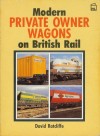 |
Title: | Modern Private Owner Wagons on British Rail | ||||||||||||
| Author: | David Ratcliffe | |||||||||||||
| Publisher: | Patrick Stephens Limited, Wellingborough, 1989. ISBN: 1-85260-062-4 | |||||||||||||
| Comments: | 168 pages, A5-sized, card-covers, 152 B&W pictures, 20 colour. This well-illustrated book sets out to describe all the privately-owned wagons registered on TOPS (ie since 1975) with tables giving build and numbering details and a narrative description of the design and operation of each type. Within the text are many useful references to liveries and details such as lengths and wheelbases. The captions of the monochrome pictures helpfully describe the colour schemes carried. UK-registered RIV wagons are included. |
|||||||||||||
| --- | ||||||||||||||
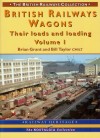 |
Title: | British Railways Wagons, Their Loads And Loading, Volume 1 | ||||||||||||
| Authors: | Brian Grant and Bill Taylor | |||||||||||||
| Publisher: | Silver Link Publishing, Kettering, 2003 (reprinted 2009). ISBN: 978-1-85794-205-7 | |||||||||||||
| Comments: | The first edition of this book was reprinted in 2009, presumably due to interest created by the second (see below). The book is rather similar to overall, with chapters on loading gauges and weight distribution (!) before it dives into brief descriptions of a wide variety of wagon designs. These range from pre-nationalisation wagons to modern air-braked private-owner ones, and there are numerous (small) drawings and photos. Almost half of the book is given over to 'Specially Constructed Wagons' and the sometimes unbelievable loads they were called upon to shift. | |||||||||||||
| --- | ||||||||||||||
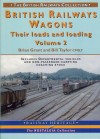 |
Title: | British Railways Wagons, Their Loads And Loading, Volume 2 | ||||||||||||
| Authors: | Brian Grant and Bill Taylor | |||||||||||||
| Publisher: | Silver Link Publishing, Kettering, 2007. ISBN: 978-1-85794-300-9 | |||||||||||||
| Comments: | 128 pages, 9in x 7in, card-covers, 238 B&W pictures, 1 colour. This book covers most types of wagons operated on BR up to the present and has a large number of diagrams and monochrome photographs. Manufacturer's literature has provided much of the material and some of the diagrams are slightly on the basic side but it is useful to have it all in one place. Obviously some of the less common types had to be excluded. There is not much in the way of text and most of what there is deals with departmental vehicles and the loading of goods wagons. Perhaps the most interesting items are the photographs of incidents with loads, such as toppled steel coils and a cracked Weltrol. |
|||||||||||||
| --- | ||||||||||||||
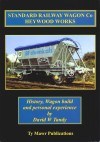 |
Title: | Standard Railway Wagon Co Heywood Works | ||||||||||||
| Author: | David W Tandy | |||||||||||||
| Publisher: | Ty Mawr Publications, Holmes Chapel, 2009. ISBN: 978-0-9552354-2-9 | |||||||||||||
| Comments: | 128 pages, 8in x 6in, card-covers, 43 B&W pictures, 67 colour. This is a well presented book detailing the products of one of the UK's most prolific and innovative wagon builders. The first few pages outline the history of the Heywood works, focusing on developments from the 1960s onwards (but illustrated with some Victorian-era 'posed workers' photos). The next chapter looks at technical developments, covering bogies and suspension, brakes, discharge mechanisms etc. The bulk of the book is given over to coverage of each type of wagon built at the works. This starts with the Blue Circle Palvans of 1965, referred to as Contract 1. For each type there is a short description and a block of data (numbers, dimensions, etc), while many also have diagrams (from the BR diagram book) and/or photos (most in colour). Quite a few photos are 'ex works' posed shots but this is no bad thing, and they haven't been used elsewhere. A total of 142 contracts were completed before the works was closed in 1992, most of which were for private owners. Perhaps more interesting are the batches of wagons built for export or UK industrial use, details of which are rarely published. The book ends with a table of all wagon builds and a glossary. It is worth mentioning that the author of this book was the Chief Designer at Standard Wagon from 1971 onwards, and the subtitle of the book is 'History, Wagon build and personal experience'. It seems to me that there is very little of the latter in this book, and it is more about 'what' Standard Wagon achieved, rather than 'how'. However, even wagon experts will probably find something here that they didn't know about. |
|||||||||||||
| --- | ||||||||||||||
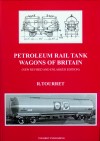 |
Title: | Petroleum Rail Tank Wagons of Britain | ||||||||||||
| Author: | R Tourret | |||||||||||||
| Publisher: | Tourret Publishing, Abingdon, 2009. ISBN: 978-0-905787-09-6 | |||||||||||||
| Comments: | 304 pages, 12in x 8in, board-covers, 688 B&W pictures. This book, a revised and enlarged edition of one published in 1980, is huge! With almost 700 photographs, along with 125 diagrams, it covers the huge variety of oil tank wagons built between 1865 (the first known example) and the present. The bulk of the book is taken up with a section outlining the history and wagon fleets of each of several hundred oil companies, distributors and wagon hirers, preceded by shorter chapters describing the industry as a whole, and the evolving technology and design of the wagons. The acknowledgments show that Mr Touret conducted a large amount of research, and the diagrams (including whole wagons, detailed components and company logos) are virtually all his own work. It has to be mentioned that there is no index, and little in the way of tables of data. Most of the information on things like dimensions and numbers (both pre-TOPS and TOPS) is there, but included in the narrative. This does make it rather hard to quickly look up things, although you will usually find something of interest along the way (such as the short-lived close coupling tried out in the 1960s). Another point is that the book is not quite comprehensive. Particularly for the earlier wagons, the text often provides details of certain wagons without stating if there were others. For example, Corn Products Co Ltd apparently had tank wagons numbered 1, 37 and 41. It is not explicit whether the other numbers were used. The lack of available information surely accounts for this, and also perhaps for the author not attempting to tabulate the wagon information. Despite these quibbles, this book is a magnificent work and must have been a labour of love for its author. The £33 price may seem high but is fair given the number of pages and photographs. Since writing this, I have read comments on one of the wagon forums that mentioned a number of errors in the book, specifically to do with number ranges and traffic flows. A few mistakes are inevitable in a work of this size but it is unfortunate these were not picked up during proof-checking. |
|||||||||||||
| Type Detail Books | ||||||||||||||
| These are books that cover a specific wagon type in greater detail. As well as the title shown, there has also been a book on the ICI bogie limestone hoppers that lasted in traffic from 1936 until the late-1990s. |
||||||||||||||
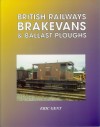 |
Title: | British Railways Brakevans & Ballast Ploughs | ||||||||||||
| Author: | Eric Gent | |||||||||||||
| Publisher: | The Historical Model Railway Society, 1999. ISBN: 0-902-835-16-5 | |||||||||||||
| Comments: | 92 pages, A4-sized, card-covers, 14 B&W pictures, 71 colour. Few types of wagon can warrant their own book but brake vans were sufficiently varied and ubiquitous. This title by the HMRS goes into levels of detail that were previously reserved for books on locos, with sections on alterations, liveries and brandings, maintainence and even the interior layouts. Given that BR built over 5000 traffic brake vans and just 221 ballast ploughs it is curious that 42 pages of this book are devoted to the latter. |
|||||||||||||
| --- | ||||||||||||||
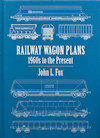 |
Title: | Railway Wagon Plans, 1960s to the Present NEW | ||||||||||||
| Author: | John L Fox | |||||||||||||
| Publisher: | Ian Allan, 2016. ISBN: 978-0-7110-3843-1 | |||||||||||||
| Comments: | 190 pages, A4-sized, hard-back, 138 colour photos, numerous drawings. |
|||||||||||||
| Wagon Picture Books | ||||||||||||||
| These are books where the bulk of the content is formed of pictures and captions. |
||||||||||||||
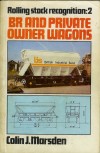 |
Title: | Rolling Stock Recognition series | ||||||||||||
| Author: | Colin J Marsden | |||||||||||||
| Publisher: | Ian Allan Ltd, 1984 | |||||||||||||
| Comments: | Ian Allan's Recognition series was expanded in 1984 with two volumes covering the revenue (BR and private-owner) and Departmental fleets respectively. Packed with black and white photos, they gave many of us a first introduction to the subject. Although the photos are rather on the small size, the coverage is good and the captions informative. As a bonus there are also lists of TOPS codes and a few small line drawings. | |||||||||||||
| --- | ||||||||||||||
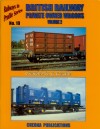 |
Title: | Railways in Profile series | ||||||||||||
| Author: | G Gamble / R Touret | |||||||||||||
| Publisher: | Cheona Publications, Chinnor | |||||||||||||
| Comments: | 14 books were published in this series up to 2001, the majority of them relating to wagons. Although on the slim side at 60 pages each, the larger format (230mm x 175mm) with generally two photos per page allows a lot of detail to be visible. Photos are mainly black & white with a few colour spreads in later titles. The range of subjects and the quality of the photographs and reproduction are all excellent, while the extended captions give a lot of detail. | |||||||||||||
| --- | ||||||||||||||
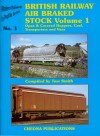 |
Title: | Modern Railways in Profile series | ||||||||||||
| Author: | Tom Smith | |||||||||||||
| Publisher: | Cheona Publications, Llanllyfni | |||||||||||||
| Comments: | These books followed on from the earlier Railways in Profile series and were to a similar format but printed in full colour. As on the real railway, the distinction between railway-owned and private wagons was no longer relevant and the three titles published to date are grouped instead by types. The photos and reproduction are excellent, my only gripe being about the range of subjects covered, this appearing to be skewed in favour of certain types. For example, Volume 2 covered 'Steel Carriers, Engineers Stock, Timber Carriers & Powder Tanks' and featured 14 photos of OTA timber wagons but none of the various types of JSA steel wagons. | |||||||||||||
| --- | ||||||||||||||
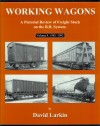 |
Title: | Working Wagons series | ||||||||||||
| Author: | David Larkin | |||||||||||||
| Publisher: | Santona Publications, Hull | |||||||||||||
| Comments: | The four books in this series cover the periods 1968 to 1973, 1974 to 1979, 1980 to 1984 and 1985 to 1992 respectively. Each has around 170 black and white photographs spread across 96 large format pages. The captions are quite detailed and include livery notes while each two page spread also has an introductory text outlining the illustrated (and related) types. As the title suggests, the photos all show wagons being used (although not always loaded) and there are none of the normal works and/or open day views. The photos are all of a high quality and the subject matter ranges from the mundane to the unique. Three later books covered the period from 1948 to 1968. | |||||||||||||
| --- | ||||||||||||||
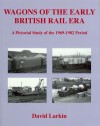 |
Title: | Wagons of the Early British Rail Era | ||||||||||||
| Author: | David Larkin | |||||||||||||
| Publisher: | Kestrel Railway Books, Southampton, 2009. ISBN: 978-1-905505-10-4 | |||||||||||||
| Comments: | I was slightly confused when I saw a book entitled 'Wagons of the Early British Rail Era (A Pictorial Study of the 1969-1982 Period)' on sale in 2009. David Larkin had followed his earlier Working Wagons series (see above) with a series of books covering earlier eras, published by Kestrel to a similar format. There was 'Wagons of the Early British Railways Era (1948-1954)', 'Wagons of the Middle British Railways Era (1955-1961)' and 'Wagons of the Final Years of British Railways (1962-1968)'. The distinction seems to be between British Railways and British Rail, but the latest book does seem to duplicate the period covered by the Working Wagons series (the change of publisher may be a factor). As mentioned, the format is similar to the Working Wagons series, with medium to large monochrome photos well printed on glossy paper. One difference is that only BR wagons are covered. There are no private owners or ferry wagons included. Two slight complaints are that one or two photos have already been featured in the Working Wagons books, while about 9 pages are given over to lengthy lists of the numbers of mineral wagons that had certain features. This information seems slightly out of place in a 'Pictorial Study'. On the plus side, the range of subjects is excellent. Coverage of some types (such as mineral wagons and air-braked vans) may seem slightly heavy but this is balanced by some real rarities such as a prototype SPA and both types of FHA experimental 'Lowliners'. The introductory text includes a full list of TOPS codes. Curiously this includes some codes introduced after the period covered (eg BUA first used in 1991), while it also agrees with my theory that the last 50 SAA wagons were actually SBAs. I didn't read this book looking for mistakes, and I'm sure there are very few, but I would love to have seen the BTVs modified to carry '37ft outside diameter pipes'! As a final note, many of the photos were taken in South London, where Mr Larkin was a signalman. This is no bad thing as the variety of wagons to be seen is remarkable. A BBA and HAAs, both in Nunhead, are examples of types still in use but only further afield. To be fair, the BBA was caught on delivery from Ashford works! |
|||||||||||||
| --- | ||||||||||||||
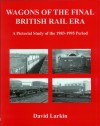 |
Title: | Wagons of the Final British Rail Era | ||||||||||||
| Author: | David Larkin | |||||||||||||
| Publisher: | Kestrel Railway Books, Southampton, 2010. ISBN: 978-1-905505-17-3 | |||||||||||||
| Comments: | 90 pages, 10.5in x 8.5in, card-covers, 197 B&W pictures. Covering the 1983 to 1995 period, the latest book in this series follows the usual format, with several pages given over to photographs of each type, along with text outlining the build details, liveries and subsequent modifications and changes. As before, many mundane types are covered, with a few gems (such as the VHA van) almost hidden inbetween. The author mentions the fact that he longer had access to official information during this period. Ironically it was also during these years that information on wagons first started to be regularly published in railway books and magazines. A couple of self-confessed 'gaps' in the story (such as the identities of the renumbered MAA wagons) could therefore have been filled. Another minor downer is the re-use of several photos that appeared in the Working Wagons series. However, the main problem with this book (which may be limited to the batch my copy came from) is the poor photo reproduction. Many of the pictures appear flat and murky, lacking contrast and thus losing detail. This is a shame as many of the photographs show rare types or long-gone workings. For example, on the cover is a HEA hopper at London Bridge! (Services to and from the wagon works at New Cross Gate were run around there). The author has plans to cover other fleets (departmental, private owner and inherited stock) in future titles. |
|||||||||||||
| --- | ||||||||||||||
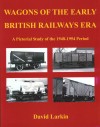 |
Title: | Wagons of the Early British Railways Era | ||||||||||||
| Author: | David Larkin | |||||||||||||
| Publisher: | Kestrel Railway Books, Southampton, 2006. ISBN: 978-0-9544859-8-6 | |||||||||||||
| Comments: | To avoid any confusion, this book is subtitled 'A Pictorial Study of the 1948-1954 Period'. These years saw the newly-formed BR starting to develop standard wagon designs and building them in large quantities. This book covers most of these, with detailed lot lists and photos (often official BR pictures but many taken by the author in later years) and also deals with conversions and some of the types inherited from the 'big four'. The photos and reproduction are generally excellent. As an aside, further volumes in the series are planned to cover the 'Later British Rail Era (1983-1994)' and the engineers fleet from 1948 onwards. | |||||||||||||
| --- | ||||||||||||||
 |
Title: | Wagon Recognition. Volume 1: Carkinds B to W | ||||||||||||
| Author: | Martin Buck and Mark Rawlinson | |||||||||||||
| Publisher: | Freightmaster Publishing, Swindon, 2008. ISBN: 978-0-9558275-0-1 | |||||||||||||
| Comments: | The first major book on modern wagons to appear for some time, this 224-page softback was published in spring 2008. I have classed it as a picture book as there is not a huge amount of text. However, it does give brief details (numbers and areas of use) for every TOPS code (except X, Y and Z groups) in use as of 2008. Where this book excels is in the photographs, of which there are more than 300. Most are reproduced at two per page but there are a number of whole page views, and the pictures are uniformly excellent. Major variants within each TOPS code are individually illustrated and some of the oddballs tracked down include a BSA, an FZA and a 6-part Italian rail-carrier. Towards the end is a selection of photos for types recently taken out of service while the limited text gives an overview of TOPS and wagon numbering as well as a guide to various wagon 'hotspots'. On the down side, many of the photographs have already been published on various websites (which makes the £24.95 price tag a bit hard to swallow) and some of the pictures seem oddly chosen. For example, the photos of both the BAA and BBA types are of markedly non-standard variants. There are also a couple of minor errors in the text and captions (such as suggesting that the original JSAs were built in 1977 rather than converted in the 1990s, and that FLA 606175/606176 was built in 1991). However, if you are new to the wagon scene or just want an easily browsable overview of what can be seen (and where), this book is highly recommended. |
|||||||||||||
| --- | ||||||||||||||
 |
Title: | Wagon Recognition. Volume 2: Carkinds - Y and Z | ||||||||||||
| Author: | Martin Buck and Mark Rawlinson | |||||||||||||
| Publisher: | Freightmaster Publishing, Swindon, 2009. ISBN: 978-0-9558275-2-5 | |||||||||||||
| Comments: | I was looking forward to this follow-up volume, thinking it would be quite some task to cover the huge variety of departmental wagons. However, a flick through this book will reveal that (in terms of 'wagons' at least) that variety is no longer there. Fleet rationalisation, and the recoding of many types back to their revenue codes, means that the only traditional wagons included are the Sealion/Seacow hoppers, Salmon/Osprey and Mullet/Parr flats, Sea Urchin opens and Shark ballast ploughs. The rest of the book covers on-track plant, which is fair enough given that these are assigned TOPS codes in the Y and Z series. Of course, the distinction between wagons and on-track plant is blurred in many cases. Although 119 of the 162 photos included are of items numbered in the CEPS (plant) series, some would otherwise be considered as 'wagons' (for example the LWRTs and sleeper carriers). The consistent high quality of the photographs, and the sheer variety and complexity of the track machines included more than compensates for the lack of pure wagons, other bonuses being the inclusion of design codes and a section outlining the functions of each major type of track machine. My only negative comments concern a couple of obvious errors in the picture captioning, and the relatively high cover price (£19.95 for 144 pages). Finally a puzzle, about TOPS rather than the book. Why are some track machines that are obviously mounted on bogies, coded in the Z-series (such as the ZWA Dynamic Track Stabilisers), while others are in the Y-series (like the YZA Stoneblowers)? | |||||||||||||
| --- | ||||||||||||||
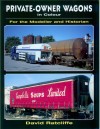 |
Title: | Private-Owner Wagons in Colour (For the Modeller and Historian) | ||||||||||||
| Author: | David Ratcliffe | |||||||||||||
| Publisher: | Ian Allan, Hersham, 2009. ISBN: 978-0-7110-3365-8 | |||||||||||||
| Comments: | The 'For the Modeller and Historian' series has covered a range of subjects in recent years, including two titles on wagons by Robert Hendry ('BR Goods Wagons in Colour' and 'BR Goods Wagons in Colour 1960-2003', although the latter also included private owner wagons). The latest title is by David Ratcliffe and is to the same large format as earlier titles, with 220 excellent colour photos on glossy paper. Captions provide details of the wagon and, often, the services they were employed on. The pictures are mainly from the 1990s and coverage is fairly good, particularly for tank wagons (90-odd photos). One exception I noticed was that the bogie container flats used for domestic waste traffic were not included. Rarities that are illustrated include Johnnie Walker and MoD Palvans, and the PMVs (ex MDV) very briefly used as scrap carriers in Scotland. This book very nicely captures the huge variety of designs (and, more notably, liveries) that characterised the PO fleet. | |||||||||||||
| --- | ||||||||||||||
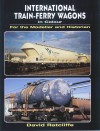 |
Title: | International Train-Ferry Wagons in Colour (For the Modeller and Historian) | ||||||||||||
| Author: | David Ratcliffe | |||||||||||||
| Publisher: | Ian Allan, Hersham, 2009. ISBN: 978-0-7110-3404-4 | |||||||||||||
| Comments: | This book is to the same format as the one above, with 222 colour photos and a good spread of subjects. As the title suggests, most of the wagons illustrated are from the pre-Chunnel era (the last train ferry operated in 1995), but a couple of more recent types are included. What really impresses in this book is the depth of the author's knowledge and research. The captions usually give information on the wagon itself, the load being carried and the destinations served. He also provides interesting contextual information, such as the actual uses of the various chemicals carried by tank wagons. | |||||||||||||
| --- | ||||||||||||||
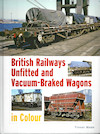 |
Title: | British Railways Unfitted and Vacuum-Braked Wagons in Colour NEW | ||||||||||||
| Author: | Trevor Mann | |||||||||||||
| Publisher: | Ian Allan, Hersham, 2013. ISBN: 978-0-7110-3636-9 | |||||||||||||
| Comments: | 96 pages, A4 sized, hard-back, 233 colour photos. This book, together with the one below, forms a pair that between them give a pretty good overview of the wagons built for BR between nationalisation and privatisation (some later views are included but types introduced more recently are not covered). Although quite slim, they pack a lot in. The first book in particular has smaller photos (usually 2 or 3 to a page) to allow for very lengthy captions. The captions themselves give general details of the type being illustrated, as well as the particulars of the individual wagon. The photos are all colour and almost uniformly excellent. Naturally it has been impossible to illustrate some types in their original forms, and quite a few are shown in later life (such as departmental and internal user vans, while the Palbrick could only be shown as a Freightliner match wagon). There are some real gems though, including several types I had never seen before (such as FTV container flat ex-Tube and XLV Lowmacs loaded with dummy nuclear flask and a Land Rover). Recommended. |
|||||||||||||
| --- | ||||||||||||||
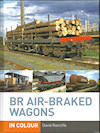 |
Title: | BR Air-Braked Wagons in Colour NEW | ||||||||||||
| Author: | David Ratcliffe | |||||||||||||
| Publisher: | Ian Allan, Hersham, 2014. ISBN: 978-0-7110-3460-0 | |||||||||||||
| Comments: | 96 pages, A4 sized, hard-back, 227 colour photos. Picking up the story from the book above, this one covers the various types built following the adoption of air-brakes as standard in the 1960s. The photos, which again are excellent, are noticeably larger, resulting in shorter captions. There is still enough text to outline the histories of each type, as well as detailing the individual wagons, and often mentioning the actual traffic flow they were working (e.g. "Columbian coal from Liverpool Gladstone Dock to Fiddlers Ferry power station"). Some types do seem to get a lot of coverage - for example there are 6 OCAs, 6 VDAs and 9 OTAs - but they do all show detail or livery differences. There was of course less variety overall in the (much smaller) air-braked fleet. My favourite photo has to be one of the YDA 'Skate' skip-carrying train actually working! |
|||||||||||||
| Wagon Number Books | ||||||||||||||
| These are ABC-type books that list wagon numbers. They range from very basic number-only lists intended for spotters, to well illustrated books giving lots of additional information. Update 01/05/2013: There have been a number of new publications over the past few years that are very basic "numbers-only" lists. Some of these manage to include all UK rolling stock in one volume. While these are no doubt useful to some people, I will only be reviewing those number books that show (as a minimum) distinctions between and within batches of wagons, such as TOPS codes. |
||||||||||||||
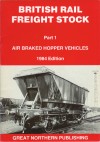 |
Title: | British Rail Freight Stock, Part 1 Air Braked Hopper Vehicles, 1984 Edition | ||||||||||||
| Authors: | Les Wild | |||||||||||||
| Publisher: | Great Northern Publishing, Doncaster, 1984 | |||||||||||||
| Comments: | This seems to be the grand-daddy of all wagon number books, appearing in 1984 as the first of a promised series that (as far as I know) never materialised. With card covers, four black and white photos and just 28 pages, it covered the air-braked hoppers of types HAA/HDA, HBA/HEA and CBA. Aside from lists of numbers (including showing withdrawn wagons) and a brief introduction, the book also featured drawings (actually BR design sheets) for the three main types. | |||||||||||||
| --- | ||||||||||||||
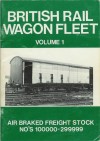 |
Title: | British Rail Wagon Fleet series | ||||||||||||
| Authors: | Peter Ifold, Stewart Mott, John Dickenson and Roger Butcher | |||||||||||||
| Publisher: | South Coast Transport Publishing, Hampshire | |||||||||||||
| Comments: | Between 1987 and 1994 a variety of books were published which covered virtually all of the BR-owned wagon fleet (the exception being pre-nationalisation wagons). The primary volumes (covering the air-braked and departmental fleets) both ran to second editions. Each batch (or lot) of wagons is listed with symbols used to show TOPS and design codes of individual wagons. Early books listed all numbers while later ones showed only those wagons still in stock, or withdrawn in the preceeding few years. Batch headings give build details and a key to the symbols used. A fair number of photographs featured in each issue with later editions having colour photos on (and inside) the covers. Also published by SCT was a list of Internal Users compiled by Roger Butcher. This detailed surviving vehicles as at 1992 and gave disposal information for all vehicles allocated IU numbers since about 1980. | |||||||||||||
| --- | ||||||||||||||
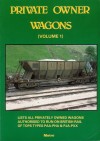 |
Title: | Private Owner Wagons series | ||||||||||||
| Author: | Andrew Marshall | |||||||||||||
| Publisher: | Metro Enterprises Limited, Shipley | |||||||||||||
| Comments: | Between 1989 and 1992 a number of titles were released by Metro Enterprises covering the private-owner and RIV wagon fleets. Widely regarded as among the best of the number books, these were well illustrated and gave full build details (including weights, lengths, etc) for each batch. Wagon numbers were shown in full (i.e. with prefixes) and former numbers were shown where known. Code letters were used to distinguish variations in TOPS or design codes. Each batch heading also indicated the areas and flows upon which the wagons were used. PO Wagons Volume 1 (non-tanks) ran to a second edition. | |||||||||||||
| --- | ||||||||||||||
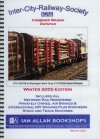 |
Title: | Combined Wagon Datafile | ||||||||||||
| Author: | David Sharpe | |||||||||||||
| Publisher: | HB Publications for Inter-City Railway Society, Birmingham | |||||||||||||
| Comments: | This annual book is perhaps the best wagon 'ABC' available at present. In a spiral-bound A5 format with laminated covers and over 200 pages, it covers all wagon types to be seen in the UK, including RIV stock, on-track plant, departmental coaching stock, internal users, channel tunnel stock and engineers stock of London Underground and the Docklands Light Railway. Basic build details are given for each batch and the TOPS code for each individual wagon is indicated through the use of symbols. This is particularly useful for batches which have seen a lot of modifications, such as the OBAs. As with any work of this scale, the odd errors are inevitable, but these are usually corrected in subsequent editions, while the open-flat binding and largish font utilised make for a very usable reference work. Each of the sections (eg Private-owner wagons) is also available as a separate book. HB Publications also produce a series of similar-format books under the title of 'BR Wagons - A Numerical History' but it should be noted that these are just lists of the numbers within each batch with no additional information. The Directory volume is to be recommended as it includes build, lot and diagram details, while Volume 12 may also be of interest as it lists all wagons given numbers in the TOPS private-owner series. One other HB/ICRS title to mention is the Preserved Datafile volume 2, this listing all known preserved wagons in the UK, a surprisingly massive undertaking. |
|||||||||||||
| --- | ||||||||||||||
 |
Title: | UK Rail Series No.3: UK Wagons 2010 | ||||||||||||
| Author: | Scott Yeates (with Paul Eveleigh and Trevor Roots) | |||||||||||||
| Publisher: | ICRS Publications, Waterlooville | |||||||||||||
| Comments: | Following the split between HB Publications and the ICRS (Inter-City Railway Society) both now produce wagon books under their own names. The ICRS effort largely retains the format (and £12 price) of the previous Combined Wagon Datafile, being A5 spiral-bound with laminated covers (upon which are the only 5 photographs). The contents are arranged in the same logical manner, covering PO wagons, BR wagons, RIV wagons, track machines, internal users and other operators (Channel Tunnel, London Underground etc) in that order. As has seemingly become the norm, the BR wagons section lumps all 6-digit numbers into one series. Three-letter TOPS codes are given for all wagons, symbols being used for variations. The compilers have made two changes to the format and these are helpfully mentioned in the introduction. Firstly, the former numbers of wagons renumbered more than 6 years ago have been omitted. This seems sensible, and reduces the space taken up by types such as the MHA and BDA. The second change is that most number prefixes have been omitted, apart from a few of the B-prefixed wagons. Fair enough for the BR series perhaps, but the loss of the private owner number prefixes is questionable. As far as I know these are still in use (witness the ongoing spread of VTG prefixes), and curiously this book does bother to list and decode the codes that it doesn't then show! The changes do mean that the book is reduced to 160 pages while still using a clear font size and spacing. I would rate this book as an improvement over the already-good Datafile series. Unless you want road-railers included (in which case go for the PTI books below) or full design codes (head for the Gardners), I would recommend this book for its balance of detail and clarity. The introduction by the way has a more complete list of RIV exchange codes (including 37!), but misses out the X TOPS GENKOC, Y TOPS BRAKTY and SLT owner code. To be fair, these are only carried by one wagon apiece! |
|||||||||||||
| --- | ||||||||||||||
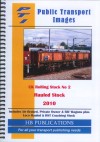 |
Title: | UK Rolling Stock series | ||||||||||||
| Authors: | Martin Hall | |||||||||||||
| Publisher: | HB Publications, Hartlepool, 2010 | |||||||||||||
| Comments: | During 2009 the relationship between HB Publications and the Inter-City Railway Society ended and each went on to produce their own versions of the former Wagon Datafile series. The HB Publications titles appeared in three parts under the PTI (Public Transport Images) brand. The three titles cover Powered Stock, Hauled Stock and Engineers Stock. This method of distinction is interesting but does have its drawbacks. For example, the Hauled Stock volume includes coaches, while it also includes some wagon types that are technically engineers stock (such as the HQA Autoballasters). In many respects the books follow the format of the earlier series, such as showing individual TOPS code variations using symbols (for some reason some show the full 4-letter AARKND while others just have the 3-letter CARKND). However, wagons with RIV numbers only show the UIC type code, not good for those of us who haven't got used to wagons being called 'Sffggmrss' or whatever! The Engineers Stock volume is rather different, with many pages devoted to small plant and road-railers (including multiple tables listing the same vehicles in different orders with a seeming lack of cross-referencing). Relatively few wagons are included, just those in the CEPs or DB-prefixed series. If you are interested in diggers that can run on railway tracks then this book is for you! To be fair to Martin, he has done a fantastic (and un-enviable) job of bringing together everything on the rails. I just feel that the format and grouping leaves something to be desired. I hope to review the ICRS books soon. |
|||||||||||||
| --- | ||||||||||||||
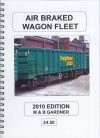 |
Title: | Wagon Fleet books | ||||||||||||
| Author: | Mark and Barry Gardner | |||||||||||||
| Publisher: | Mark and Barry Gardner, Leicester | |||||||||||||
| Comments: | I have finally got around to obtaining a set of these books and can now provide a fairly positive review. Broadly similar in content and format to the ICRS/HB book mentioned above, there are two significant differences. Firstly, the books include the design code for every wagon. This is achieved using the same method as the old Metro and SCT books, ie through the use of symbols and letters. These also show variations in TOPS code and weights. Although fine for most batches, on some of the older (and more modified) batches, the result can be a bit muddled and I did find at least a couple of instances where a symbol was used without an explanation. The addition of design codes is welcomed though, as it is not included in any of the other current books. Strangely there are no AARKNDs shown, all TOPS codes being three letter. The second difference is that the books come as four volumes, with between 44 and 70 pages and a cover price of £4.50 each (post free if you buy all four). Although it would be nice to have it all together, you do at least get more covers (and hence more photographs!). I should add that a combined volume is also available but I understand that this has less detail and is more of a basic numbers list. Storage locations are given for some of the older types while a nice addition at the end of each book is a list of wagons no longer on TOPS but still on the network. Each book has a short introduction, outlining things like prefixes and TOPS series. As with other books, these are nearly but not quite comprehensive. For example, exchange code 37 (now common) is not explained, while XAA wagon SLT98997 is listed but neither the TOPS group X nor the owner code SLT are in the tables. The books are only available by post, the address being listed in Rail Express magazine each new year (or send me an e-mail for the details). |
|||||||||||||
| --- | ||||||||||||||
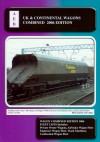 |
Title: | UK & Continental Wagons Combined | ||||||||||||
| Author: | n/a | |||||||||||||
| Publisher: | AEB Rail Publications, Preston | |||||||||||||
| Comments: | This book appears to be more aimed at pure wagon spotters than those with much interest in the subject. It covers all the same types as the ICRS title above but each block of numbers is headed with very basic details, and the numbers are just that, with no additional information. For example, the OBA fleet is headed "OBA 2-Axle Open Goods (OCA/ZDA/ZCA/OBA/RRA etc)" and there is no indication of which wagons are to which code. Prefixes (other than for private-owner wagons) are not included. Lastly, the use of 'perfect' binding seems less than ideal as the book will not lay flat and would appear to be prone to damage if used a lot. | |||||||||||||
| --- | ||||||||||||||
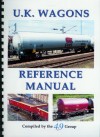 |
Title: | UK Wagons Reference Manual | ||||||||||||
| Author: | n/a | |||||||||||||
| Publisher: | The 429 Group, Macclesfield | |||||||||||||
| Comments: | This comb-bound, 166 A4 page book with laminated covers is a valiant effort to catalogue all recent domestic wagons in the UK. It is printed to order so is always up to date and the price of around £20 includes several sheets of updates through the following year. The pages are evidently produced from a spreadsheet program and there is a complex method of colour-coding to show the status of each wagon. As there are four columns per side, the amount of space for additional information is limited. Although relatively compact, there are a number of issues which mean that this cannot be seen as a definitive 'reference manual'. Firstly, RIV wagons are not included. The listings are purely numerical with no prefixes (although PO prefixes are outlined in each batch header). This makes it had to identify the pre-nationalisation wagons that are scattered throughout the number ranges. Similarly, TOPS codes of individual wagons are not shown, being dealt with in the same way as the AES book mentioned above. The book shows wagons that have been disposed of in recent years but with no indication of when (or indeed what the cut-off date is). Most importantly, only one piece of information can be shown against each wagon. This means (for example) that a renumbered wagon in service will show the previous number, but one that is in store will show the storage location. This book may suit some but I would prefer to have paid twice as much for something with twice as many pages and more complete information. | |||||||||||||
| --- | ||||||||||||||
| Other ABC-type titles (such as those by Dave Goswell) will be reviewed in the near future. | ||||||||||||||
| Wagon Modelling Books | ||||||||||||||
| Among many modelling books there seems to have only been that deals exclusively with the subject of modern wagons. |
||||||||||||||
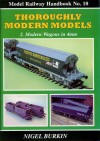 |
Title: | Model Railway Handbook No.10: Thoroughly Modern Models. 2. Modern Wagons in 4mm | ||||||||||||
| Author: | Nigel Burkin | |||||||||||||
| Publisher: | Irwell Press, Clophill, 1998. ISBN: 1-871608-69-4 | |||||||||||||
| Comments: | 80 pages, A4, card-covers, 174 B&W pictures, 16 colour. Although mainly relating to models, this book does contain lots of prototype photographs (including useful detail views) and the text gives an overview of TOPS, the various wagon types covered and developments in UK railfreight. The remaining photographs are of models, ranging from just-opened kits to complete wagons, added to which are a handful of drawings and diagrams. The chapters cover various classes of wagon (vans, steel wagons, coal hoppers etc) and each includes a couple of projects ranging from RTR detailing to full scratch-building. The only drawback of this book is the frequent reliance on products from the now-defunct Appleby Model Engineering range. However, the techniques should hold good for kits from other firms. |
|||||||||||||
| --- | ||||||||||||||
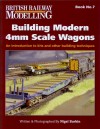 |
Title: | Building Modern 4mm Scale Wagons | ||||||||||||
| Author: | Nigel Burkin | |||||||||||||
| Publisher: | Warners Group Publications, Lincolnshire, 2010. ISBN: 978-1-907292-11-8 | |||||||||||||
| Comments: | 144 pages, 9.5in x 7.5in, card-covers, colour photos throughout. This is book number 7 in the British Railway Modelling series, one of the earlier titles also having covered modern wagons (although limited to the detailing of ready-to-run models). It seems Nigel Burkin has cornered this market but, going by the quality of his work, this is no bad thing. This book covers wagon kits (plastic, white-metal, etched metal and resin) and scratch-building, with a number of examples of each being selected for a 'step-by-step with photos' treatment. The tools and techniques involved in construction and finishing are also considered, and there are some excellent ideas on weathering. There are a few prototype photographs but no drawings as such. However, there are hundreds of colour photographs, showing models at various stages of construction, and a further selection of larger photos at the rear showing completed models in a scenic environment. It is interesting to note that, compared to the book above (published 12 years earlier), this one has almost double the number of pages (albeit slightly smaller format) and hugely more photographs, all in colour. Yet it costs just £1 more (£11.99 vs £10.95). |
|||||||||||||
| Wagon Magazines | ||||||||||||||
| To the best of my knowledge there has only ever been one periodical devoted to modern BR wagons and it would appear that the availability of internet forums and the like has caused its demise. |
||||||||||||||
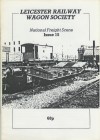 |
Title: | National Freight Scene | ||||||||||||
| Publisher: | Leicester Railway Wagon Society. 1987 to ? | |||||||||||||
| Comments: | This magazine started out as a bi-monthly 12-page, photocopied and stapled, A5 booklet with a cover price of 35p! Its stated aim was to complement the wagon news articles in the mainstream railway magazines by providing "general fleet movements, surveys of workings and yards and details such as livery changes and interesting survivors". It also included a few type profiles and drawings, though the photograph reproduction was often very poor. Its strength was defintely in collating reports and sightings of the older and/or more interesting wagons, and they went on to produce booklets on brake vans, internal users and crane match wagons as well as listing survivors of types such as the BR ferry vans. I only have issues up to number 21 but the magazine went on to at least issue 81 (in 2000), still to the same format but now with card covers and 32 pages. Perhaps as a reflection of the decreased variety in the wagon fleet by then, these later issues appear to be more just lists of routine sightings. | |||||||||||||
| Other Books | ||||||||||||||
| These are books where wagons are not the main subject matter but which nevertheless include some information and/or photographs. |
||||||||||||||
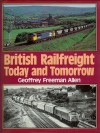 |
Title: | British Railfreight - Today and Tomorrow | ||||||||||||
| Author: | Geoffrey Freeman Allen | |||||||||||||
| Publisher: | Jane's Publishing Company Ltd, London, 1984. ISBN: 0-7106-0312-6 | |||||||||||||
| Comments: | 144 pages, A4, 164 B&W pictures, 1 colour. This book provides an overview of the freight scene in the UK in the mid-1980s and deals with the politics and economics of railfreight as well as detailing the services operated. Each chapter considers a particular commidity and there are also sections on TOPS (including a list of codes) and the private wagon industry. Photos are a mixture of views of trains and portraits of individual wagons. Two rare types included are the VHA curtain-side van and the 6-wheel bogied FHA. The maps of freight terminals provide an interesting comparison to those in more recent Freightmaster books, while there are also drawings of several planned wagon types, some of which were never actually built. |
|||||||||||||
| --- | ||||||||||||||
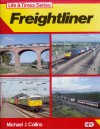 |
Title: | Life and Times series: Freightliner | ||||||||||||
| Author: | Michael J Collins | |||||||||||||
| Publisher: | OPC (Haynes Publishing Group, Sparkford), 1991. ISBN: 0-86093-455-1 | |||||||||||||
| Comments: | 128 pages, A4 hardback, 211 B&W pictures, 4 colour. This book describes the development of the Freightliner concept from its inception in the mid-1960s up to the sectorisation of the late 1980s. Chapters deal with the origins, the (then) current operations, services (inlcuding sample timetables), the traction, terminals, wagons and containers. Two further chapters look at other rail-borne container applications, and an entertaining description of a cab ride in a Frieghtliner train from Ipswich to Willesden. The chapter on wagons is probably of most interest, and it describes the prototypes and production wagons as well as the various other types built over the years. Tables of numbers and build details are included both here and in the containers chapter, although the latter covers only those built for Freightliner itself. |
|||||||||||||
| --- | ||||||||||||||
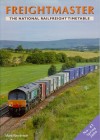 |
Title: | Freightmaster (The National Railfreight Timetable) | ||||||||||||
| Author: | Mark Rawlinson | |||||||||||||
| Publisher: | Freightmaster Publishing, Swindon | |||||||||||||
| Comments: | New editions of this book have appeared at regular intervals since the mid-1990s and, as the title suggests, give information on the times of freight trains running across the UK. Due to the nature of the services involved, the presentation is nothing like a traditional passenger timetable. Instead, each book is split into two sections. The first lists trains scheduled to pass through a wide variety of locations, called 'hotspots'. Most cover all services between 07:00 and 23:00 but a handful provide 24 hour coverage. Each train is shown with time and direction of passing, headcode, days of operation, origin, departure time, destination, likely traction and the type of train. The second part looks at each main traffic in turn, with maps to show the terminals and routes served. A subscription-based on-line version of the book is also available. Although perhaps of not much direct interest to wagon enthusiasts, these books are the best way to track down freight trains and each also provides an interesting overview of the UK freight scene at the time of publication. | |||||||||||||
| --- | ||||||||||||||
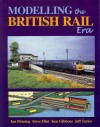 |
Title: | Modelling the British Rail Era | ||||||||||||
| Authors: | Ian Fleming, Steve Flint, Ken Gibbons and Jeff Taylor | |||||||||||||
| Publisher: | Santona Publications, Hull, 2001. ISBN: 0-9507960-8-5 | |||||||||||||
| Comments: | This 96-page, card-covered book is well illustrated, mainly in colour. It attempts to provide an introductory guide to modelling modern BR, covering prototype information, methods and available models. A large part of the book is given over to freight trains, with photographs and drawings relating to the wagons and terminals used on various flows. Possibly the best feature are the 6 highly-detailed wagon drawings by Colin Craig, covering bogie ferry vans, coal container wagons, traditional grain hoppers, alumina/lime hoppers, PRA china clay wagons and Chlorine tanks. These are almost worth the £14.95 cover price themselves. Also of interest are the layout plans which suggest ways of incorporating various freight terminals within a realisable floorspace. | |||||||||||||
| --- | ||||||||||||||
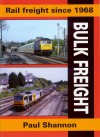 |
Title: | Rail freight since 1968 series | ||||||||||||
| Author: | Paul Shannon | |||||||||||||
| Publisher: | Silver Link Publishing, Kettering, 2008 | |||||||||||||
| Comments: | This is a series of books covering the main 'sectors' of freight traffic, written by one of the acknowledged experts on the subject. I was not tempted by them at first, as my interest was more in the wagons than the services operated. The numerous monochrome photographs were mainly of whole trains rather than individual vehicles. However, when writing profiles for this site, I have often had to hunt high and low for details of changes to freight services. These books bring all this sort of information together, outlining the history of each major traffic flow, the customers served, and the wagon types used. The Bulk Freight title is perhaps the most interesting, with chapters on aggregates, construction materials, waste, minerals, metals and oil. Sample timetables are given for a few operations, while the index usefully includes freight terminals and customers. Other titles seen are 'Coal' and 'Wagonload'. | |||||||||||||
| Other Magazines | ||||||||||||||
| There are many magazine titles on the subject of Britains railways but three in particular regularly featured news and articles about wagons. |
||||||||||||||
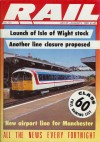 |
Title: | Rail Enthusiast / Rail | ||||||||||||
| Publisher: | EMAP, Peterborough. 1981 to present | |||||||||||||
| Comments: | Bob Wallace has a lot to answer for! The first of his 'Wagons Roll' columns appeared in the June 1984 issue of what was then Rail Enthusiast, and it opened my eyes to an aspect of the railway I had barely noticed before. The articles were an interesting mix of news, background information and type profiles, with the odd bit of nostalgia, and several photographs were included each time. Rail Enthusiast became plain 'Rail' in 1988 and switched from monthly to fortnightly in 1989, with Wagons Roll appearing in alternate issues. Later issues carried fleet changes for each month although pressure of space meant that these were mainly limited to the air-braked railway-owned types. The privatisation of BR caused the supply of information to dry up and for a while the articles were predominantly pictorial. The March 1996 issue carried the last article by Bob Wallace, after which coverage became very intermittent and limited. The magazine became more and more targetted at railway professionals and featured less about the trains and more about the business of running trains. It is worth mentioning the Departmental Developments column by Roger Butcher. These appeared in almost every issue across the same time span (1984 to 1996) and often covered departmental wagons as well as the more usual coaching stock and on-track plant. Location reports were often produced and there were regular updates on the internal user fleets. | |||||||||||||
| --- | ||||||||||||||
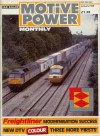 |
Title: | Motive Power Monthly | ||||||||||||
| Publisher: | Ian Allan, Shepperton. 1986 to 1991 | |||||||||||||
| Comments: | Motive Power Monthly was a rebranding of Modern Railways Pictorial, itself an offshoot of Modern Railways. As an aside, Modern Railways covered major wagon developments up to the mid 1980s. MPM started off with a regular wagons column written by Roger Silsbury. This ran to two or three pages and was often accompanied by one or two pages of large photographs. The content was a mixture of news and background information and the articles featured in most issues until the magazine's demise in 1991. There were also articles on freight flows and yards and works (such as Carlisle Currock) that featured photos and information on the relevant wagon types. | |||||||||||||
| --- | ||||||||||||||
 |
Title: | Rail Express | ||||||||||||
| Publisher: | Foursight Publications, Peterborough. 1996 to present | |||||||||||||
| Comments: | As the re-titled Rail magazine tended more towards the business aspects of the industry, rival Rail Express was launched to cater for the enthusiasts. From the first issue there were one or two pages devoted to wagons under the title of 'Wallace's Wonderful World of Wagons'. As the name suggests, these were written by Bob Wallace, formerly of Rail. The coverage was pretty much as per Wagons Roll but the photos were in colour from the outset. There was a slight hiatus in 2003 when the authorship passed from Bob Wallace to Rob Volland and then to Gareth Bayer but the column continues and is perhaps the best source of up-to-date news on the current wagon scene. Rail Express is also to be recommended for including details of relevant wagons in various articles about freight flows, both in the main section and in the modelling pages that later became a regular feature. | |||||||||||||
| --- | ||||||||||||||
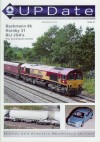 |
Title: | UPDate | ||||||||||||
| Publisher: | DEMU (Diesel and Electric Modellers United), 1995 to present | |||||||||||||
| Comments: | UPDate is the quarterly magazine for members of DEMU. The subject matter varies from issue to issue but there is usually some freight-related content. Articles are split between product reviews, prototype information and modelling projects, and there are often drawings of rolling stock. Many of the members of DEMU are real wagon experts and some of the best articles are theirs, including a multi-part study of PGA hoppers (with numerous diagrams and photographs). Similarly detailed articles have looked at subjects such as track, overhead line equipment and various locos, coaches and wagons. | |||||||||||||
| --- | ||||||||||||||
 |
Title: | Railway Modeller | ||||||||||||
| Publisher: | Peco | |||||||||||||
| Comments: | This magazine has occasional features on wagons, most usually about how to model certain types. Wagons from most eras have been covered, often with prototype photographs and drawings. In the early 1980s there was a series of articles about modern freight trains, covering aspects such as liveries, brake types and TOPS codes. | |||||||||||||
| --- | ||||||||||||||
 |
Title: | Model Railway Constructor | ||||||||||||
| Publisher: | ? | |||||||||||||
| Comments: | Although I don't have any copies myself, articles in this magazine (and its 'annual' book offshoot) are often referred to in other wagon books and magazines. Perhaps somebody could supply some more information for the purposes of a review. | |||||||||||||
| Page added: 22/01/2008 | Spotted an error? Got some additional info? Please e-mail me at tom (at) ltsv.com |
Last edited: 10/07/2016 |
